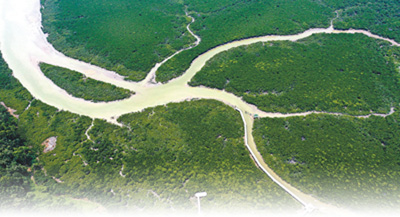The Shankou Mangrove National Nature Reserve in Hepu county, Beihai city, south China's Guangxi Zhuang Autonomous Region, is one of the first five national marine nature reserves in the country.
Established in 1990, the nature reserve has 919.6 hectares of mangrove forests and 10 exclusive mangrove species.

Photo shows a portion of the Shankou Mangrove National Nature Reserve in south China's Guangxi Zhuang Autonomous Region. (Xinhua/Zhang Ailin)
Thanks to years of protection efforts, the nature reserve, which is an important stopover for migratory birds along the East Asian-Australasian Flyway, has become a wetland of international significance.
"These days we spotted black-headed gulls, a species under first-class state protection in China, on the beach. This indicates that the coastal wetland environment of the Shankou mangrove forests is continuously improving," said Wei Jie, deputy head of the Yingluo management station of the nature reserve's management center.
Wei added that the sound and suitable wetland ecological environment and abundant food sources have attracted many birds, while the birds' foraging activities can effectively control pests in the mangrove forests.
The number of bird species recorded in the nature reserve reached 245 in 2023, an increase of 27 species compared to 2008. In the same year, there were 613 species of insects in that reserve, more than double the number in 2008.
In 2023, the nature reserve treated 273.53 hectares of tidal flat encroached by Sporobolus alterniflorus, commonly known as smooth cordgrass, an invasive species that is very prolific and leads to a decline in biodiversity. By 2025, 90 percent of the plant in the nature reserve will be removed.
Mangrove forests are recognized as one of the most effective ecosystems for storing carbon, said Liao Xin, deputy director of the Guangxi Key Laboratory of Mangrove Conservation and Utilization.
While supporting the nature reserve in planting and restoring mangroves in recent years, the Guangxi Mangrove Research Center of the Guangxi Academy of Sciences has also been actively conducting research on carbon sink methodology in the field of blue carbon to enable the mangrove ecosystem to contribute to China's "dual carbon" goals.
Compared to terrestrial forests, mangroves play an irreplaceable role in protecting coastlines, mitigating disasters, maintaining biodiversity, storing carbon, purifying seawater, and scientific research.

- Guangxi makes key achievements in protecting mangrove national nature reserve
- Hechi Bronze Drums: Most beautiful harmony at Guangxi Sanyuesan Festival
- Rice noodle industry sees rapid growth in Guangxi
- Guangxi's foreign trade sees surge in tech-intensive green product exports
- Safeguarding national security bill passed in HKSAR LegCo
- Guangxi's foreign trade hits record high in Jan-Feb
Popular Videos
Hot comments
- China Life: Chinese women shine with She Power
- First apes at U.S. zoo receive COVID-19 vaccine made for animals, zoo official says
- 86-year-old grandma in Hebei spends most her life on traditional cheongsam
- Homemade curling videos trending in China
- Asia is young!
- Lantern Festival: A romantic celebration in China
- Chinese F1 driver Zhou Guanyu says halo device saved his life after scary crash
- Nanning handles 60,000+ tons of aviation cargo in 2022
- 63-year-old Chinese master carpenter turns YouTube influencer
- Child sex offenders to be strictly punished
Top Reviews
- Guangxi makes key achievements in protecting mangrove national nature reserve
- Democracy as a profiting tool for US
- China moves to further boost payment convenience for foreigners
- GLOBALink | Chinese democracy has valuable lessons for world: Pakistani scholar
- West doesn't have monopoly over democracy
- Xi calls on Hunan to write its chapter in Chinese modernization
- Xi congratulates Prabowo Subianto on election as Indonesian president
- Prabowo Subianto wins 2024 Indonesian presidential election
- Xizang celebrates 65 years of democratic reform
- China's home-grown hydrogen energy urban train completes test run







